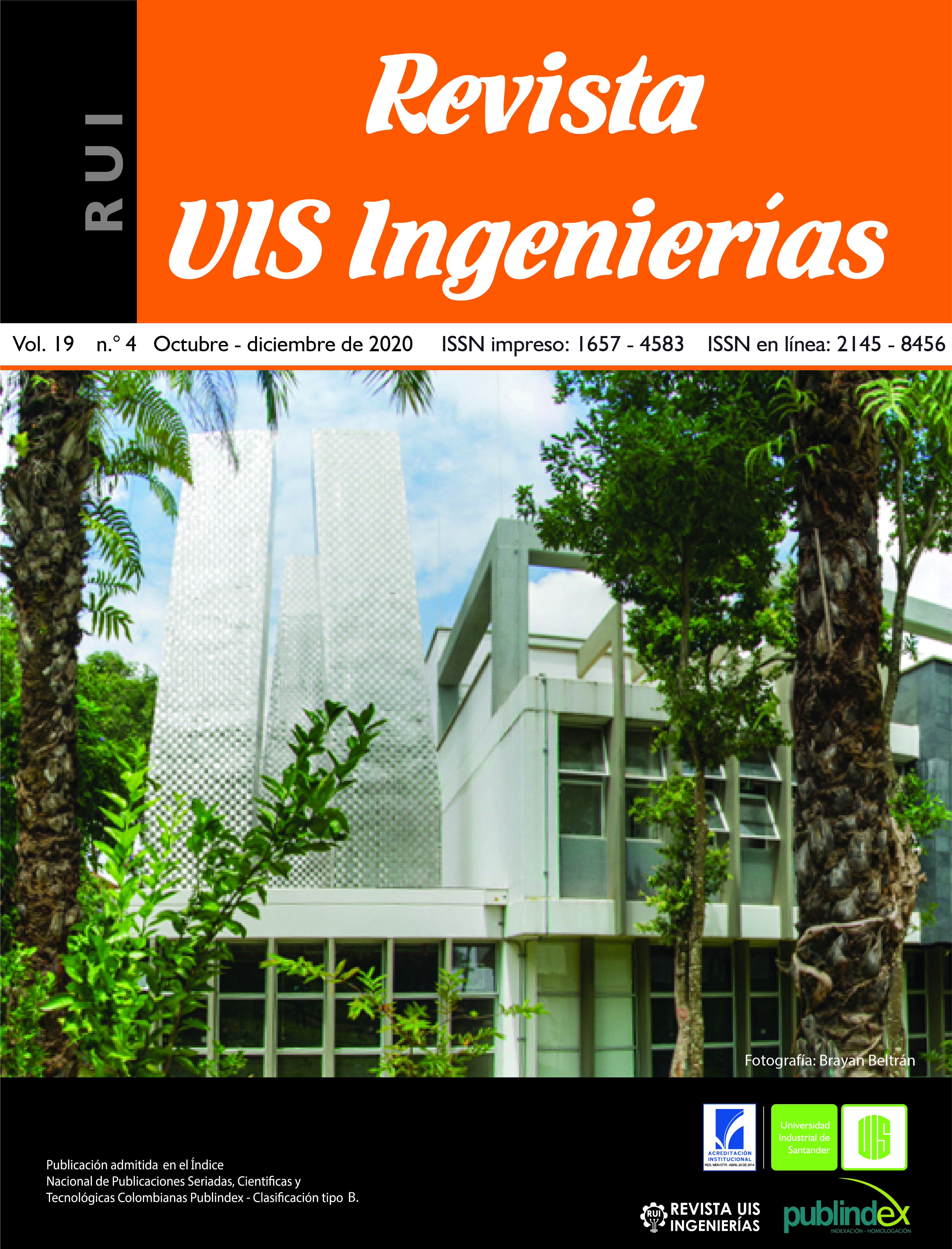Use of Bézier curves in the design of the displacement law of the cam-follower mechanism: Von Mises effective Stress
Published 2020-07-27
Keywords
- Bezier curves,
- cam design,
- distortion energy,
- Von Mises stress,
- cam-follower mechanism
- Bernstein base polynomials,
- contact theory ...More
How to Cite
Copyright (c) 2020 Revista UIS Ingenierías

This work is licensed under a Creative Commons Attribution-NoDerivatives 4.0 International License.
Abstract
D
Designing cams by Bézier Curves has become increasingly common, since the mathematical development of this method is less complex. Bezier curves are Bernstein-based polynomials under a unitary domain, and in that sense, this article presents the design of a cam using Bezier curves of degrees 5, 7 and 9. And beyond, this article seeks to show the variation of the effective effort of Von Mises in a cam-follower mechanism composed of a disc cam and a roller follower with translation movement and force closure. The expressions that allow determining the variation of Von Mises' effort for each of the curves used are presented. This variation is presented by means of graphs in which it is observed that as the degree of the curve increases, the magnitude of the efforts is greater, and this increases the probability of failure in the mechanisms. In addition, it was found that there is an inverse relationship between the stress and the radius of the primary circle of the cam.
Downloads
References
[2] A. Torabi, S. Akbarzadeh, M. R. Salimpour, M. Khonsari, “On the running-in behavior of cam-follower mechanism,” Tribology International, vol. 118, pp. 301-313, 2018, doi: 10.1016/j.triboint.2017.09.034
[3] C. H. Acevedo Peñaloza, “Estudio del ángulo de presión y de la presión de contacto en mecanismos leva palpador cuya ley de desplazamiento se diseña por curvas de Bézier,” tesis doctoral, Universidad Politécnica de Cataluña, Barcelona, 2005.
[4] F. P. Beer, E. R. J. Jonhnston, J. T. DeWolf, D. F. Mazurek, Mecánica de Materiales, México D.F.: McGraw-Hill, 2010.
[5] O. A. González-Estrada, S. Natarajan, C. Graciano, “Reconstrucción de tensiones para el método de elementos finitos con mallas poligonales,” Rev. UIS Ingenierías, vol. 16, no. 1, pp. 23-34, 2017, doi: 10.18273/revuin.v16n1-2017003
[6] T. T. Nga Nguyen, S. Kurtenbach, M. Hüsing, B. Corves, “A general framework for motion design of the follower in cam mechanisms by using non-uniform rational B-spline,” Mechanism and Machine Theory, vol. 137, pp. 374-385, 2019, doi: 10.1016/j.mechmachtheory.2019.03.029
[7] M. Shirzadegan, A. Almqvist, R. Larsson, “Fully coupled EHL model for simulation of finite length line cam-roller follower contacts,” Tribology International, vol. 103, pp. 584-598, 2016, doi: 10.1016/j.triboint.2016.08.017
[8] C. H. Acevedo Peñaloza, E. Zayas Figueras, S. Cardona Foix, “Introducción al diseño de perfil de levas por Curvas de Bézier,” Respuestas, vol. 9, no. 1, pp. 39-44, 2004.
[9] G. N. Băsescu, I. V. Crîșmaru, S. I. Strugaru, . C. Paulin, E. S. Bârcă, C. Munteanu, “The Stress Distribution of a Layered Contact Cam Mechanism Using Finite Element,” Advanced Materials Research, vol. 837, pp. 316-321, 2014, doi: 10.4028/www.scientific.net/AMR.837.316
[10] H. F. Quintero, L. Vanegas, “Use of the VAP function in the design of cam-follower mechanisms,” Ingeniería y Competitividad, vol. 18, no. 2, pp. 207-216, 2016, doi: 10.25100/iyc.v18i2.2169
[11] M. Hidalgo Martínez, E. Sanmiguel Rojas, and M. A. Burgos Olmos, “Design of cams with negative radius follower using Bézier curves,” Mechanism and Machine Theory, vol. 82, pp. 87-96, 2014, doi: 10.1016/j.mechmachtheory.2014.08.001
[12] S. C. Foix and D. C. Costa, Teoria de Màquines, Barcelona: Ediciones UPC, 2000.
[13] J. F. Olmedo Salazar, E. A. Vasconez Endara, B. H. Culqui Culqui, M. T. Piovan, “Aplicación de Curvas de Bézier en el diseño y optimización de levas para alta velocidad,” Ciencia, vol. 20, no. 2, pp. 144 -159, 2018, doi: 10.24133/ciencia.v20i2.1212
[14] R. L. Norton, Cam design and manufacturing handbook, New York: Industrial Press, Inc., 2009.
[15] S. P. Timoshenko and J. N. Goodier, Theory of Elasticity, New York: McGraw-Hill, 1970.
[16] M. Dežman and A. Gams, “Rotatable cam-based variable-ratio lever compliant actuator for wearable devices,” Mechanism and Machine Theory, vol. 130, pp. 508-522, 2018, doi: 10.1016/j.mechmachtheory.2018.09.006
[17] A. Ponter, M. Engelhardt, “Shakedown limits for a general yield condition: implementation and application for a Von Mises yield condition,” European Journal of Mechanics - A/Solids, vol. 19, no. 3, pp. 423 - 445, 2000, doi: 10.1016/S0997-7538(00)00171-6
[18] C. Acevedo Peñaloza, S. Ramón Ramón, G. Prada Botia, “Comparison of the Concentration Factor of Stresses on Flat Sheets with Two Holes with Low and High Speed Voltage Test,” Contemporary Engineering Sciences, vol. 11, no. 55, pp. 2707 - 2714, 2018, doi: 10.12988/ces.2018.86288

